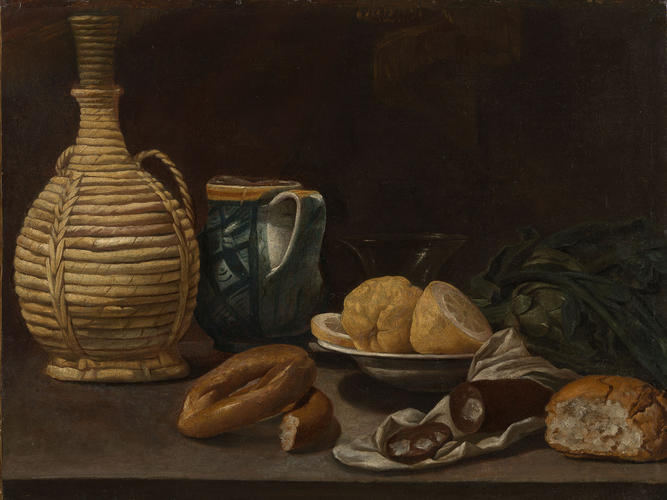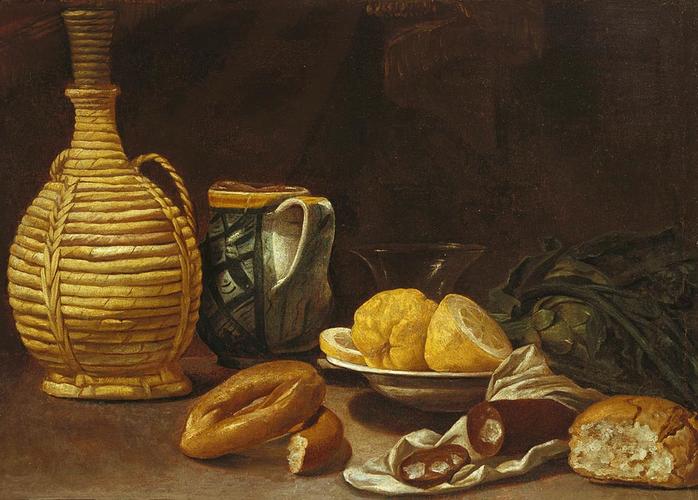Still Life with a Wicker Wine Flask, Lemons and Bread c.1615-1630
Oil on canvas | 55.7 x 73.3 cm (support, canvas/panel/stretcher external) | RCIN 402944
-
Still Life with a Wicker Wine Flask, Lemons and Bread was acquired by Charles I from James Hamilton, 3rd Marquess of Hamilton (first Duke after April 1643) in exchange for a painting of grapes and other fruits by El Labrador.
The Marquess of Hamilton was a keen art collector, principally acquiring paintings through his brother-in-law Basil Feilding, Baron Feilding of Newnham Paddox, who was ambassador to Venice and the princes of Italy between 1634 and 1639. During this period Hamilton purchased over 400 pieces, primarily by acquiring the entire collections of merchant Bartolomeo della Nave, the Procurator Priuli, and the artist Nicolas Renieri. Hamilton also inherited a collection of paintings from his father, the second Marquess, and he acquired additional works while campaigning in Germany. Like other members of the coterie of art collectors at court, including the Duke of Buckingham, Hamilton exchanged, gifted, and sometimes sold paintings to Charles I. His total collection of paintings, marbles, and other works of art may have included as many as 1000 pieces.
During the seventeenth century the painting was believed to be by an Italian artist; however, from 1732 it was attributed to the Spanish still-life painter Juan Fernandez el Labrador (fl. c.1631 - 1657). In the early twentieth century, this attribution was called into question. In 1934, A.L. Mayer, author of a monograph on Velazquez (1936), disparaged the attribution to Labrador, suggesting instead that the picture was close to the work of the young Diego Velazquez. He went on to state that while the picture is unlikely to be by Velazquez, it is 'certainly it is later than 1600. The Flask in this form is very unusual for Spain; it would indicate rather a Neapolitan origin', Mayer concluded by suggesting that the picture may have been executed between 1615 and 1630. In 1976, Eric Young, also an authority on Spanish painting, confirmed that the painting could not be attributed to El Labrador but suggested that it was by a Spanish artist contemporary with, but inferior to, Labrador. More recently, Dr Peter Cherry suggested that the painting was by an Italian artist.
Still-life painting flourished in Southern Europe in the seventeenth century. In the Spanish-ruled Naples, dramatic and naturalistic still-lifes were produced by a school of painting strongly influenced by Caravaggio. Fruit, vegetables and other foodstuffs were depicted alongside serving vessels, rendered with intense realism and detail. In Spain, the bodegón (the Spanish word of still-life) transcended its traditional status, rising to the same heights as other genres at the hands of artists including Juan Sánchez Cotán, Francisco Zurbaran and Velazquez. The wicker wine flask and bread in this painting maybe intended as Eucharistic motifs, which often played a prominent role in Catholic Counter-Reformation art. While the comestible items in many still-life paintings serve no obvious allegorical purpose, they can be viewed as reminders of the transient nature of luxury, the virtue of temperance, or the perils of gluttony. These paintings, known as Vanitas, are intended to carry a moral message as reminders of the vain emptiness of worldly things.
There is reason to believe that the painting may have been cut down from a larger composition, based on the unusual shape of the curtain in the background and the frige seen at the very top.Provenance
Acquired by Charles I from James Hamilton, 3rd Marquis of Hamilton (1606-1649); recorded in 1639 in the King's Chair Room at Whitehall Palace; recovered at the Restoration, it appears in the Third Privy Lodging Room at Whitehall in 1666.
-
Creator(s)
Previously attributed to (artist)Acquirer(s)
-
Medium and techniques
Oil on canvas
Measurements
55.7 x 73.3 cm (support, canvas/panel/stretcher external)
73.4 x 91.0 cm (frame, external)
Category
Object type(s)
Alternative title(s)
Still Life









